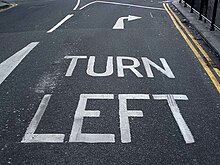Commons:WikiProject Signs

Welcome to the WikiProject Signage on the Wikimedia Commons! We are a group of people dedicated to the creation, categorization and distribution of free images, videos, and other media related to all types of signs, banners, billboards, markings, inscriptions, and all other types of visual data representation collectively known as signage.
Members edit
Tasks edit
General edit
- Take pictures of various kinds of signage in different languages and countries.
- Help to solve requests of files.
- Help with recognizing Category:Unidentified-language signage.
- Help with categorizing files in Category:Signage.
Maintenance categories edit
- Plaques to people missing a People category
- Plaques to ??? missing a ??? category << fixme
Current edit
- Rethink, reorganize, and clarify the differences and relationships between Signs on trees, Trees with signs, and Tree signs.
- Write a guide about how to deal with categorization issues.
How to edit
- Open deep subnational plaque category (Plaques in Poznań)
- Move non-plaques to a different category using Cat-a-lot
- Move all visible plaques to <LANG>-language plaques in <COUNTRY>
- Open gallery slideshow and go though each image; adjust the language of those that don't match the rest (because they are bilingual or in another language)
Definitions edit
In English, the lexeme "sign" has many related and overlapping meanings. Per Wikidata, in decreasing order of abstractness:
- sign (Q262246) – "concept in semiotics or linguistics"
- sign (Q3695082) – "semiotic concept; object, quality, event, or entity whose presence or occurrence indicates the probable presence or occurrence of something else; includes words, punctuation, expressions, gestures, notices, road signs, symbols, pictures, etc."
- sign – physical instance of Q3695082, regardless of purpose, material, or message.
| Property type | Property | Example cat.
Replace "signs" with "theme name" |
Note |
|---|---|---|---|
| Visual | color | Red signs | All visible signs have this property. |
| shape | Square signs | ||
| Physical | condition | Damaged signs | Only physical signs have this property.
Diagrams have no material and therefore no condition. |
| material | Metal signs | ||
| Temporal | year | 2014 signs | Can be the date the sign was installed, a date referenced on the sign, or the date the picture of the sign was taken. |
| Linguistic | language | Polish-language signs | Signs often have inscriptions, and inscriptions are often linguistic.
A language always implies at least one writing system (in pictures, that is). |
| writing system | Hiragana signs | ||
| Inscription | Stop signs by inscription – СТОП |
| |
| Spatial | location | Signs in Switzerland | Only physical signs can have this property. Only signs in an unusual position are categorized.
Diagrams have no material and therefore no location. |
| position | Leaning signs | ||
| Identificatory | name | Zeichen 267 | As "legal objects", some regulatory signs have an officialized name. |
| Purposive | function | Prohibition signs | All signs have a purpose/function. Signs with an unobvious or undetermined purpose/function can be considered art. |
| Other | style | ? | TBD |
| object | ? | TBD | |
| type | ? | TBD |
* Note: Diagrams of signs have no spatial properties, because they are virtual entities in and out of themselves — as opposed to photographs, which are virtual representations of real-life physical objects that do have spatial properties.
- traffic sign (Q170285) – "plate with instructions (warning, prohibitory, mandatory, ...) used to control traffic on the road"
- banners, billboards, murals, to smaller street signs, street name signs, sandwich boards and lawn
Types of signs edit
- Inscriptions are instances...of text
- Road signs
- Street signs
- Fingerposts (sometimes referred to as a guide post) – posts with one or more arms — known as fingers — pointing in the direction of travel to named places on the fingers. Sometimes, fingerposts will also show the distance to the location. They can be found as road, bye-way and footpath signs, and as directional signs in parks and gardens
- House numbers – "house IDs"
- Monuments and memorials – an object of any kind defined primarily by the commemorative or dedicational intent behind its creation.
- Gravestones –
- Statues – statues themselves rarely feature inscriptions, but their pedestal sometimes do
- Pedestals – the supporting part of a statue or a vase, and of a column in architecture. They sometimes feature inscriptions.
- Plaques – commemorative objects categorized under monuments and memorials that are not graves.
- Stolpersteine – a subtype of plaques. Ground-based by definition and square by custom.
Special cases of multilingual signs edit
-
Quinquelingual Chinese-English-French-Italian-Portuguese sign with Russian added by hand.
-
Quadrilingual or Quinquelingual Chinese-English-Malay-Tamil sign with a fifth language added by hand.
Relation to inscriptions edit
Most signs feature inscriptions, and most inscriptions convey linguistic information. Notable exceptions include pictograms (which are inscribed but extralinguistic), and language-neutral inscriptions (which are linguistic, but not language-specific).
Conversely, inscriptions are often signs. For the purpose of categorization on Commons, texts contained in books are not a subset of signs.